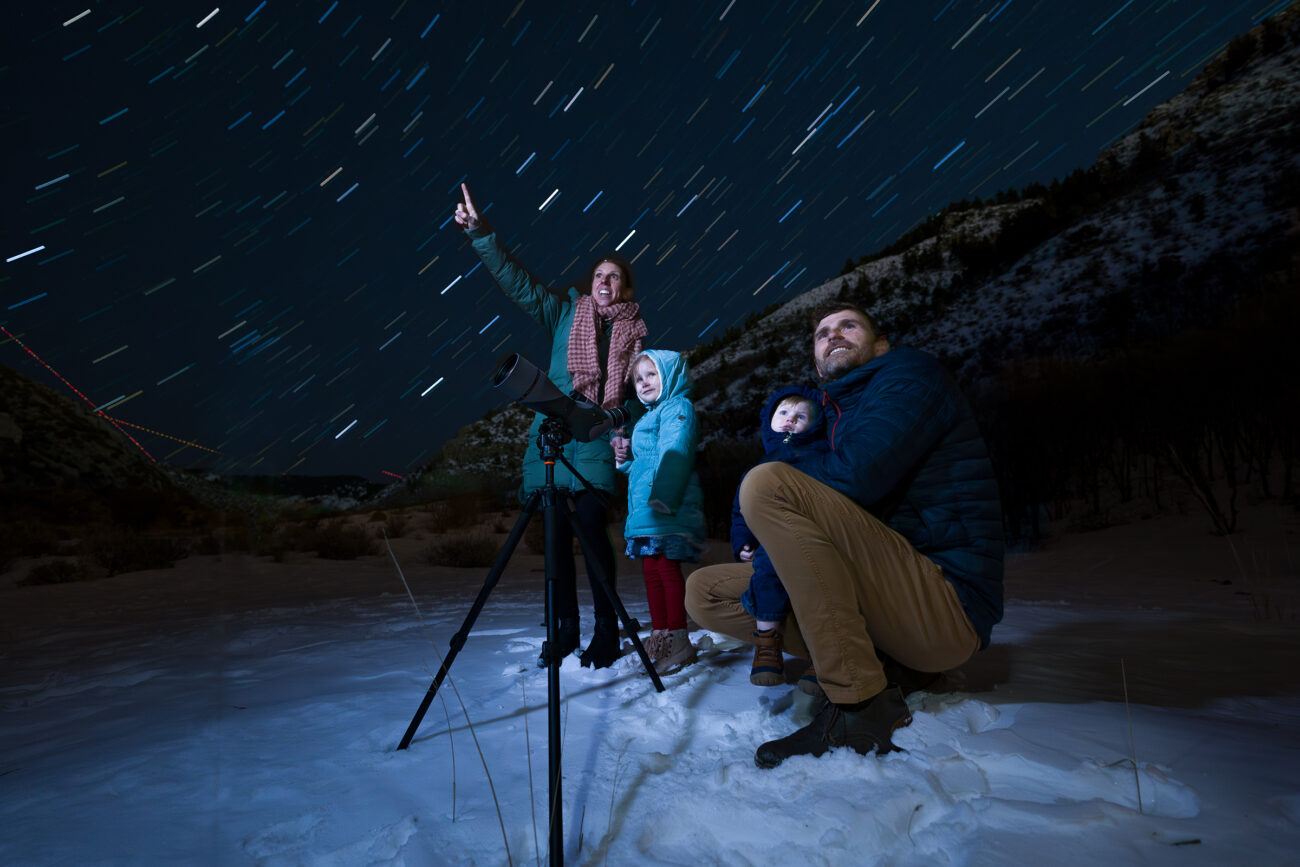The Urban World
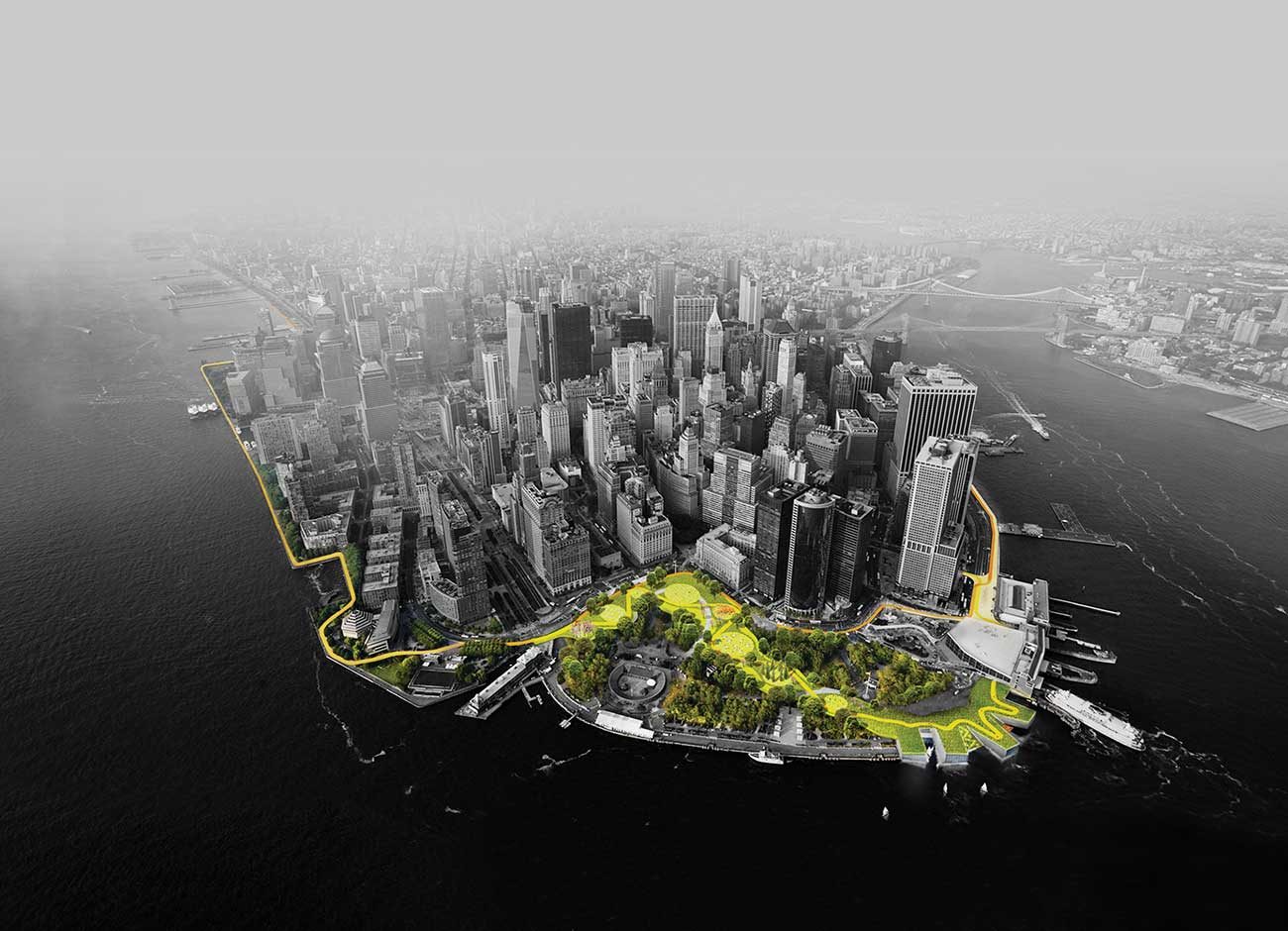
On paper, Xiongan New Area looks green.
Islands of trees surrounded by meandering riverways that scallop neatly gridded streets. There are no cars in sight. China’s model city looks somehow both orderly and organic. And it doesn’t yet exist. The cities of the future are being built today. Some, like Xiongan New Area, are colossal planned metropolises with high-speed rail and designed to ease congestion in nearby megacities.
The cities of the future are also the ones people live in today that are implementing policies and public works projects to gradually transform the urban landscape. Like New York City’s plans to safeguard lower Manhattan from the next Superstorm Sandy with a 10-mile greenbelt ribbon that USU alumna Jamie Maslyn Larson’s firm designed. But cities are ever-changing organisms. Cities, by definition, require people. And people change. Locks change. Earthquakes level cities. Floods sink them. Epidemics shape cities, too. They tend to disproportionately gut the poor and blow open the cracks in society.
In 1832, during the height of a cholera epidemic, wealthy New Yorkers fled the city in stagecoaches for the countryside. Upwards of 3,500 people, many poor immigrants, perished from a disease they didn’t yet understand. Two centuries later, COVID-19 revealed similar disparities. While bodies piled up in refrigerated tractor trailers, headlines like “How will cities survive the coronavirus?” forecasted the end of urbanity. History will likely prove otherwise.
Seventeen years after the 1832 cholera epidemic occurred, New York’s population had doubled. The United Nations projects that 70 percent of people will live in cities by 2050, with the largest clusters being in Asia and Africa. COVID-19 is unlikely to be the force to upend that. But it may shape how cities evolve.
A Reckoning
COVID-19 has forced an unexpected reckoning as many people like Stephanie Tomlin, MS ’18, a planner for the Utah Department of Transportation, suddenly find themselves spending a lot more time at home.
“There has been this whole push to the shared transportation economy like micro mobility [think ebikes] and mobility as a service [think Uber],” she says. “What is that going to look like after having this pandemic shake up? And then transit? That’s a whole other discussion. Now all of a sudden it’s a really bad thing to be in the same space as someone.”
Tomlin sees potential in the pause to check for blindspots and course correct, if needed.
“We don’t have very many times in history where we have been forced to stop. We have an opportunity to change if we want,” she says. “There is a lot of research on how we develop habits and it’s that we just get conditioned to do things—like our regular commute—more often, people are not considering that there could be another way.”
UDOT is examining data for clues. During the first two weeks of April there was a 70 percent decrease in traffic volumes throughout the state’s major arterials. Air quality improved. Strava data increased 100 percent.
“It really was the renaissance of biking and walking because basically our whole existence was really simplified down again to ‘What are the things that we have?’” Tomlin says. Salt Lake City, like many urban centers with lockdowns, closed some roads and repurposed travel lanes so that people could safely get outside since sidewalks are too narrow to social distance effectively.
“We don’t have very many times in history where we have been forced to stop. We have an opportunity to change if we want.”- Stephanie Tomlin
“When we open back up, why do we have to go back?” Tomlin says. “We always wish for these opportunities to just take a hard stop and reevaluate. I really hope from that standpoint that it is really treated as such. The pessimist in me is [things are] just going to go back to normal.”
There is also the possibility that train riders will abandon transit altogether and return to single occupancy vehicles.
“From an air quality and congestion perspective that is not a good thing,” Tomlin says. “Then we would be, unfortunately, worse off than we were before.”
COVID-19 identified the need to build more resilient transportation systems. But what does a resilient system look like? A more holistic one, Tomlin says. “We realize it’s not one size fits all. I think that is really at the heart of vibrant cities.”
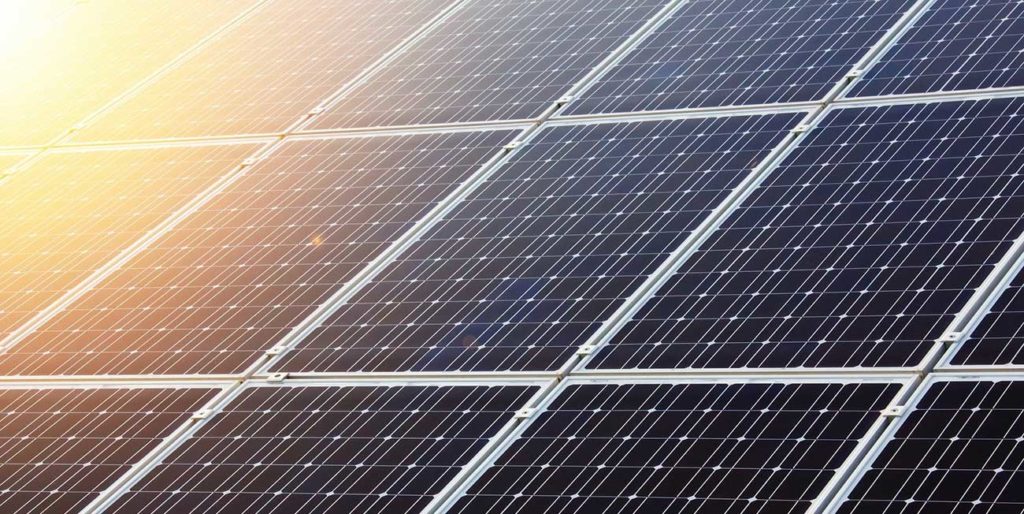
Scaling Green Energy
Chemistry professor Tianbiao Liu’s lab website features a cheery cartoon landscape dotted with windmills, solar panels, pine trees, and electric vehicles. The lab fuses disciplines like engineering and biochemistry because tackling the energy storage problem can’t just be chemistry alone, Liu admits. “I am very hopeful we can make something useful.”
In 2019, he received a five-year, nearly $600,000 National Science Foundation Faculty Early Career Development Award to develop scalable flow battery technology for renewable energy storage—a problem that has long plagued solar and wind technology adoption. Flow batteries are different from the lithium batteries used in cell phones and scale well, making them more ideal for serving as a backup supply for cities.
“They are safer. We can build them in large sizes,” Liu says. “They are very good for renewable energy storage like solar and wind energy. You can use them to power your house and your appliances.”
Flow batteries are essentially tanks of electrolytes that store energy for later use. Many flow batteries function by using a rare metal called vanadium and nontoxic, durable alternatives are in short supply. But Liu’s group is working to address this problem. In 2018, they devised an iron-based organic flow battery that maintained its charge after 1,000 cycles. Further advances could bridge the latency problem with solar and wind electricity, making energy sources more stable and reliable.
“Right now, there isn’t an affordable safe energy storage for renewables available,” Liu says. “That is something we want to make to address the storage challenges. Once that happens you can significantly reduce the reliance on fossil fuel electricity.”
“Right now, there isn’t an affordable safe energy storage for renewables available. That is something we want to make to address the storage challenges. Once that happens you can significantly reduce the reliance on fossil fuel electricity.” – Tianbiao Liu
Liu points to countries like Germany and Denmark that use solar energy as the major source of residential electricity supply. While he doesn’t think solar can replace all uses of energy in the United States, he believes more than half of residences will be powered by it in the next two decades. “I think that is very realistic.”
He also predicts cities across the West will be powered by solar.
“There is an ongoing transition right now,” Liu says. “If our battery becomes a larger option, then I think that will significantly speed up the transition to solar energy.”
Liu also sees avenues forward with AI smart technology in our homes and vehicles that could save materials and reduce emissions. Big improvements in clean energy will occur “if we are serious and if we invest in true science and technology,” he says. “That is my belief as a scientist.”
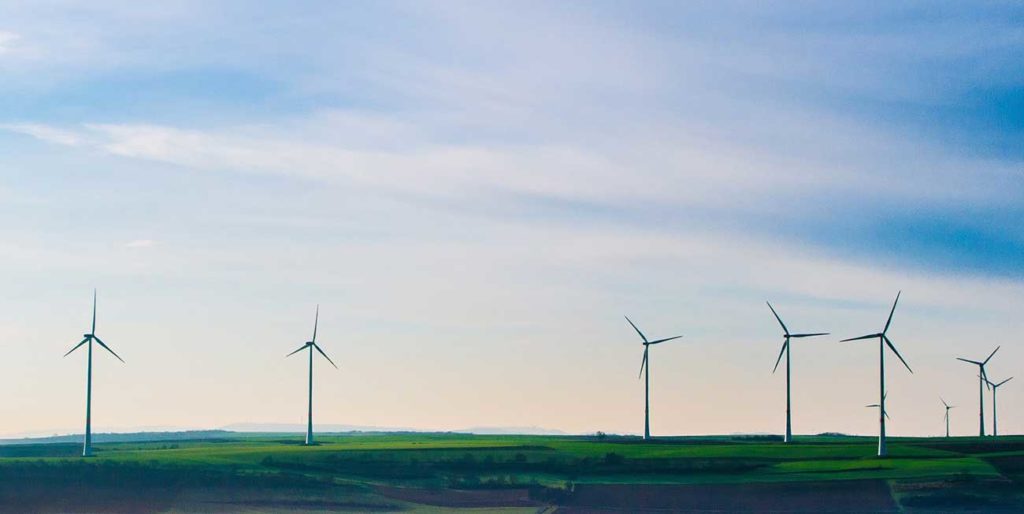
City Meets Nature
Less Mad Max, more rooftop gardens. That’s the future Sarah Klain wants to see.
“When I watch movies like Star Wars or Bladerunner, they have all these dystopian cities of the future that are devoid of plants and animals,” the assistant professor of natural resources says. “I think the cities of the future have trees. They figure out how to work with nature.”
Her vision centers on the idea that cities should be designed to promote human well-being. Trees, green space, and equitable access to walking paths are part of that. In 2013, Klain co-authored a review of scientific papers analyzing the benefits of nature that found “knowing and experiencing nature makes us generally happier, healthier people.”
“I am deeply skeptical of things like building skyscrapers where we can grow food in them,” Klain says. “From an energy point of view, that is impractical, but we can have more integration of trees and community gardens and green space to feel healthier.”
Klain studies perceptions of renewable energy sources such as wind. And controversy abounds depending on one’s geography.
“In Iowa, wind is like another crop,” she says. “You can have these farmers who have an even more dependable stream of income because of wind than only relying on their industrial soy or corn crop. Texas is actually a model for engaging the public in creating a vision of the energy future that Texans want—and they chose to invest in wind farms.”
In places like rural Texas, it may be easier to swap oil derricks for windmills—both generate income for landowners, and there are less people to complain about the sight of them, Klain says. “A lot of the controversy with wind comes when areas are valued for other things like pastoral value.”
Offshore wind farms hold enormous potential for powering swaths of the East Coast but have significant hurdles. Projects can get stymied with lawsuits or community pushback. Consider the Cape Wind Project. The proposal opened the door to future offshore wind projects in the United States, but was never built, whereas a similar project conceived at roughly the same time, the London Array, now produces enough energy to power 500,000 homes in the United Kingdom.
Moving projects further off shore makes projects more expensive, but companies are less likely to run into controversy, Klain says. “Th e potential is huge but there is a big difference between the realized and the potential.”
She remains hopeful they play a substantial role in powering coastal cities in the future.
“There is no such thing as a carbon neutral city—yet,” she smiles.
Plan for All Needs
In March, Caroline Lavoie, professor of landscape architecture, was on sabbatical in India when she got a call from the university: come back now.
As COVID-19 locked down the world’s second largest city, it underscored the problems that all communities face to varying intensities: water pollution, air quality, inequality.
“When we talk about the health of the city, it is not just retail. We have got to have all the other needs fulfilled. With COVID-19, I think people realize the depth of their needs.” – Caroline Lavoie
“What COVID-19 did is really prove that the boundaries don’t exist in the way that we think of,” Lavoie says. “We all need to cooperate and to align at all levels … because the air, the virus, and the water, they don’t have boundaries.”
When she visited New Delhi, fine particulate matter level in air crested levels four times the amount considered unsafe in Utah. During the lockdown, levels dropped into the single digits. Blue skies emerged. In cities like Jalandhar, residents were mesmerized by a sight not seen by some in decades: mountain peaks 120 miles in the distance.
“When we talk about the health of the city, it is not just retail,” Lavoie says. “We have got to have all the other needs fulfilled. With COVID-19, I think people realize the depth of their needs. It’s also spiritual connection to the place we live. Some of the needs are to be able to see the sky. To be able to see this connection with nature.”
The effects of the pandemic showed her how cities need to become more equitable.
“We need places to work, places to socialize, places to feel part of a community and a landscape,” she says. “We need places to grow food. We need places to learn. Places of worship and spiritual significance. And that can be a church or that can be the river. And each of those calls for specific typology of space or service.”
Landscape architects like Lavoie aim to convert challenges into opportunities. In Bangalore, Lavoie co-taught a design studio at Christ University and an urban ecology workshop for women focused on growth in Pune, a rapidly growing city near Mumbai. Lavoie pushed her students and colleagues to invite city stakeholders during the process, because sometimes you just need one person to excite who can move fresh ideas forward.
“I saw the urgency of acting and that is not in 50 years, that is now,” she says. “Because in 10 years the city will change completely. Even if there is one idea that they take from the students from the project, I am hopeful that things can be better.”
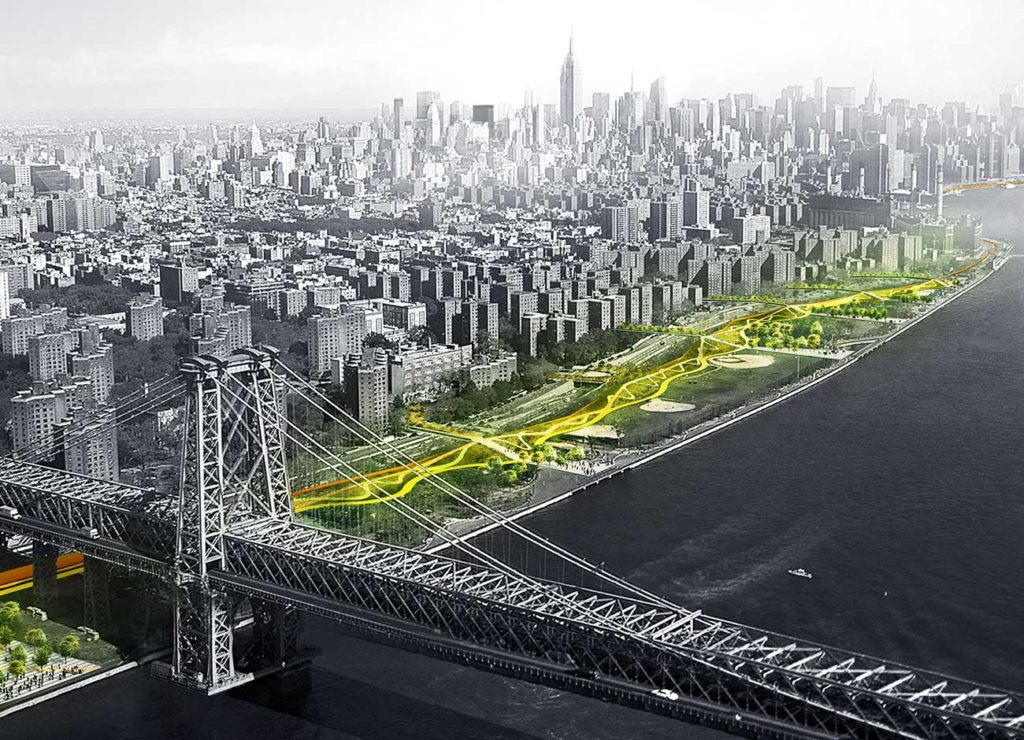
The BIG U transforms the landscape of lower Manhattan to protect against future climate vulnerabilities exposed by Hurricane Sandy. Image by BIG Bjarke Ingels Group.
Anticipate Change
Jamie Maslyn Larson MLA ’97 is not an impatient person.
“I am a landscape architect, and that means that whatever I design today, I will need to wait 20, 30, 40 years to really meet the vision,” she says.
The director of landscape for Bjarke Ingels Group New York has helped design some of the city’s most ambitious public projects in recent history. While at the firm West8, she helped transform Governors Island from an abandoned military base in New York Harbor to a site that could attract development. The design sculpted hills up to 70 feet high across the once flat 172-acre island to account for predicted sea level rise. They used the landscape as a tool to integrate climate change solutions in a space that people could enjoy, Larson says.
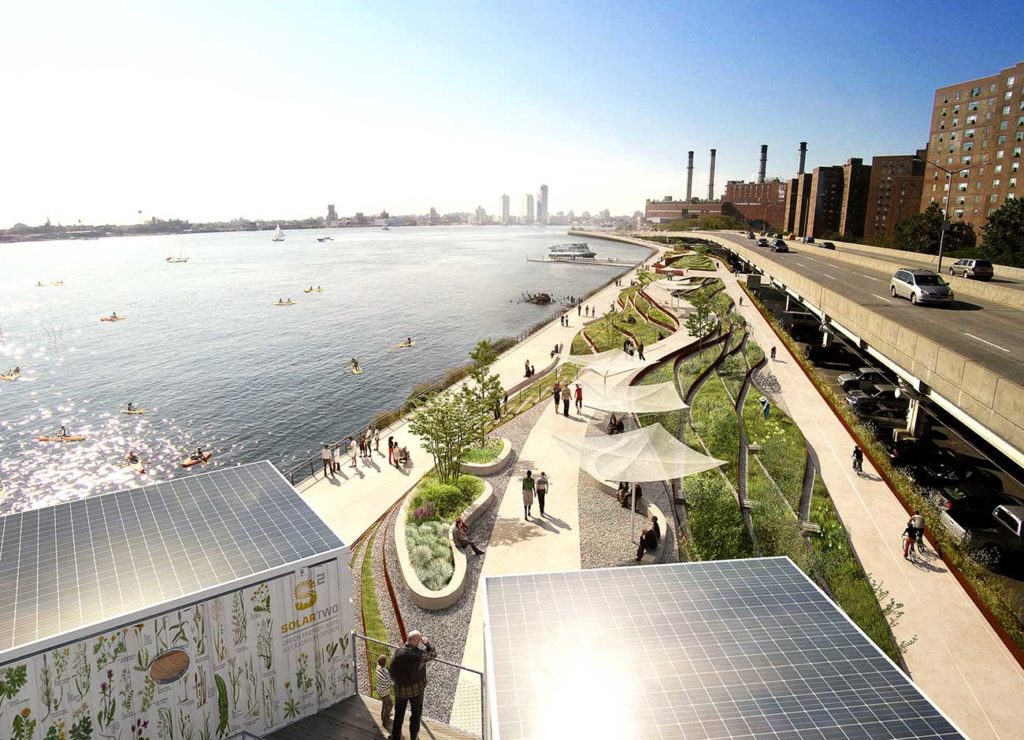
The BIG U is on good days, a space to recreate. During storm surges, a buffer for lower Manhattan. Image by BIG-Bjarke Ingels Group.
Planning for climate change is a requirement of all her projects. “It’s not an option not to think about it,” she says. “This is how we shape the future, looking through the lens of climate change.”
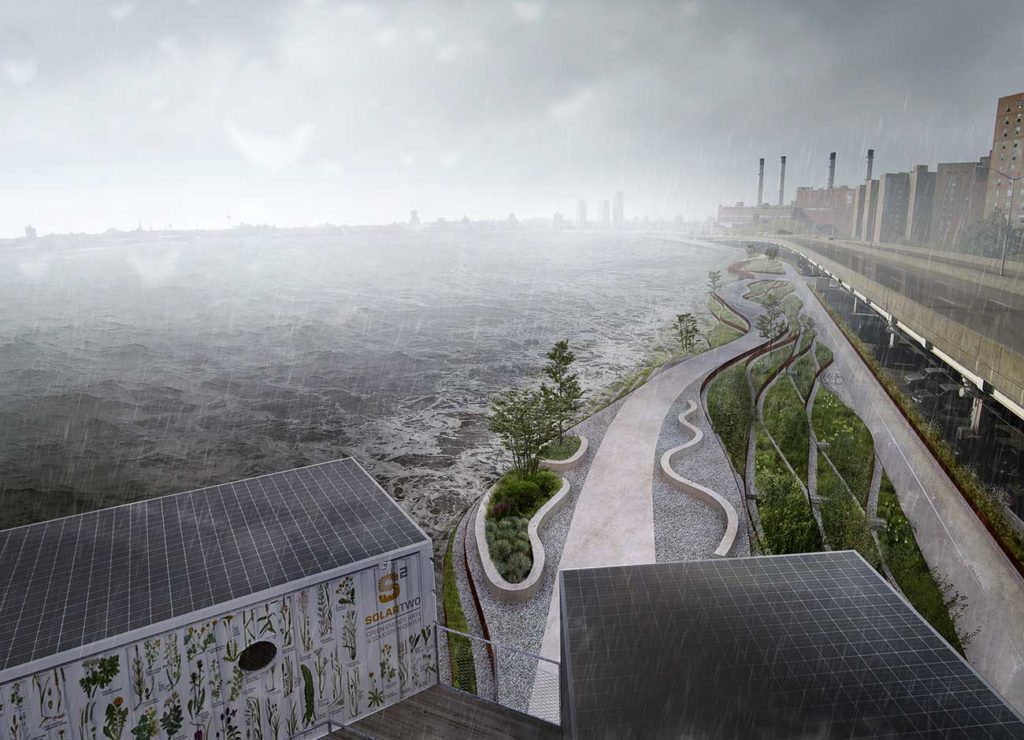
The BIG U blends public space with practical solutions to mitigate climate change hazards such as flooding. Image by BIG-Bjarke Ingels Group.
During Hurricane Sandy in 2012, a 14-foot storm surge flooded much of lower Manhattan and caused $19 billion in damage across New York City. Afterwards there was a move to improve resiliency through design. Larson’s firm BIG NY was awarded $335 million to develop “The BIG U,” a 10-mile ribbon of raised pathways and berms to protect lower Manhattan from future surges. Construction began this summer for one phase of it.
COVID-19 is a different kind of disaster that has designers like Larson considering how cities can recover and build resiliency into the urban fabric.
“You would think that the result would mean that we shouldn’t have density,” she says. “But density is actually one of the things that makes a healthy vibrant community and a healthier planet. We see the opportunity to change mobility.”
“Everyone has the opportunity right now to experiment and say ‘Is this worth it?’”- Jamie Maslyn Larson
She sees exploring alternative transportation options and how we use shared streets as an opportunity for cities to explore.
“I know that a lot of people are saying this is the end of cities, but cities have proven to be incredibly efficient and also provide more than just density,” she says. “They are epicenters of culture and art and that I think is important for our humanity. It’s really asking the question ‘How does our urban fabric better support transportation and mobility in ways that aren’t confining but rather liberating?’”
But it’s not an easy fix. And while other pandemics have catalyzed reinvention, it requires experimentation and an openness to learn, she says.
And reinvention involves “strategically bold” action. Like the mayor of Paris who wants to swap plaza concrete for trees around historical landmarks which could reduce heat island effects as the city experiences more hot days, Larson says.
“Everyone has the opportunity right now to experiment and say ‘is this worth it?’” Larson says. “What are the benefits? If we take away a lane and add a bike lane or if we take away a lane and add more green, let’s evaluate it. But doing nothing is kind of a weak position because if you are not willing to experiment, then you are not willing to change anything.”






